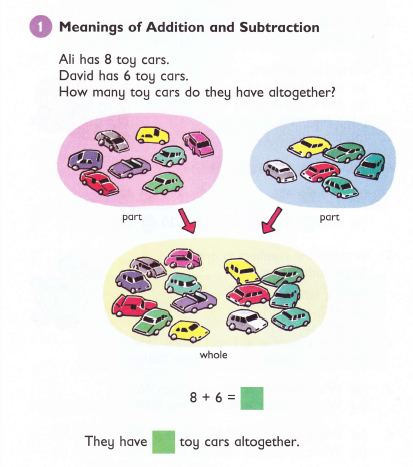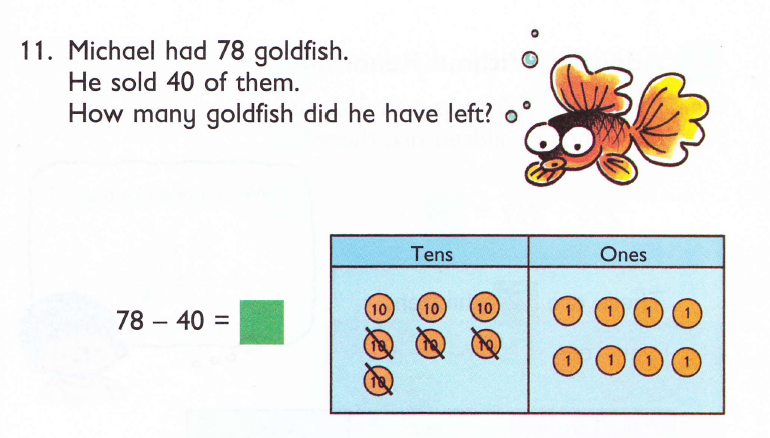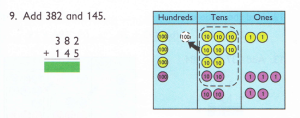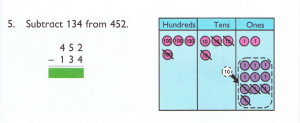Whether you use Saxon or Singapore, Math Mammoth or Math U See, the AL Abacus can help your kids understand addition and subtraction better and help them develop deeper number sense. (If you didn’t read my previous post about why I love the AL Abacus so much, you might want to click over there first to get an idea of what the abacus does before you dive into this post.)
I began writing a long, complicated post about how to teach with the abacus in your homeschool, when I realized that what I really wanted was to just sit down with you and show you. So, I’ve made four short videos that demonstrate how to use the AL Abacus to teach:
- beginning addition
- mental math with two-digit numbers
- how to add three-digit numbers with regrouping
- how to subtract three-digit numbers with regrouping
I’ve also outlined five steps to using the AL Abacus with any addition or subtraction lesson, plus how to transition your child from using the abacus to solving problems on paper or mentally. After all, the goal of using the abacus is to understand math so well that you don’t need the abacus. This post will show you how!
Videos: How to Teach Addition and Subtraction with the AL Abacus
The great thing about the abacus is that you truly can use it with any math curriculum to help your child solidify the basics of number sense, addition, and subtraction. For each of the videos below, I’ve taken a problem from a different curriculum (in this case, Singapore Primary Mathematics 2A ) and “translated” it onto the abacus.
Video: How to teach simple addition on the AL Abacus
Many curriculum present simple addition as piles of disorganized objects to count. Using the abacus helps your child to see the numbers as groups, not just objects to count one-by-one.

Video: How to teach mental math on the AL Abacus
The abacus is terrific for teaching kids to use their understanding of place value to solve mental math problems.

Video: How to teach multi-digit addition on the AL Abacus
The abacus makes regrouping and trading easy when teaching multi-digit addition or subtraction. 
Video: How to teach multi-digit subtraction on the AL Abacus

5 Steps to Using the AL Abacus with Your Curriculum
Now that you have a general idea of how to teach with the abacus to teach, here are five steps to help you use the AL abacus with your curriculum.
1. Decide which side of the abacus to use.
The abacus has two sides. Use the blank side (with the AL circle in the top right corner) for mental math up to 100. Use the side labeled 1000, 100, 10, 1 if you are working with larger numbers, or if you are doing any regrouping or trading (as in two-digit vertical addition or subtraction).

2. Familiarize your child with the abacus.
Before tackling a new concept, give your child some time to understand how the abacus works. Enter some numbers on the abacus and have your child say what number the beads show. Then, tell your child a number and have her enter the correct number of beads. (See my previous post for pictures of numbers entered on the abacus.) For example, if you wanted to teach your child how to do multi-digit addition, you would have her enter some three- and four-digit numbers on the labeled side of the abacus.
3. Translate the concept you are teaching to the abacus.
This is where your curriculum’s student book or teacher’s manual comes in handy. Take a look at the pictures they use to illustrate the concept, and translate those to the abacus, as I did in the videos above. Take it slowly, work through several examples, and make sure every step makes sense to your child. Ask plenty of questions to check for understanding, especially when it comes to regrouping and trading.
4. Allow your child to use the abacus as he begins using the new concept to solve problems.
Keep the abacus handy and let your child use it while completing the first few assignments with the new concept. This will help solidify his understanding and really make the new concept stick.
5. Encourage your child to transition to solving math problems without the abacus.
As a friend joked this week while talking about her daughter’s math progress, “The abacus is helping her understand what she’s doing. But I don’t want her to have to keep one in her purse when she’s an adult to make change!” She’s absolutely right! The goal of using the abacus (or any manipulative) is to eventually no longer need it. Manipulatives are a tool to help kids understand what they are doing so they can make the leap to solving problems on paper or mentally.
To prevent the abacus from being a crutch, gradually reduce how much your child uses the abacus as she masters the new concept. For example, here’s how you might wean your child from the abacus when learning multi-digit addition:
- At first, use the abacus for every problem, carefully trading beads to regroup.
- After your child understands the concept of regrouping thoroughly, encourage her to only enter the first addend on the abacus, and then imagine adding the beads for the second addend. For example, if your child is adding 265 + 379, she might enter 265 on the wires but only visualize sliding up the beads for the 379.
- Once she can solve problems reliably this way, put the abacus away. Pull it out only if your child gets confused or stuck, but otherwise encourage her to solve the problems on paper.
Buy your own AL Abacus here to start reaping the benefits for your kids.
Happy Math!




Hi
Do you have a step by step lesson plan guide or a curriculum with worksheets and visuals.
How do i access the electronic interactive Al abacus Ms Cutter is using in her web cast?
I don’t have a full lesson plan guide or curriculum, but RightStart Math (at rightstartmath.com) offers a full curriculum that uses the abacus heavily. I believe you can buy the electronic abacus at the app store for your phone or tablet.
Hi there, my internet access is quite terrible and I was wondering if you have any books or worksheets for sale on how to use this abacus? I also do not own a smart phone, or any mobile phone. I only have a pc which has terrible internet connection. I am a homeschooling mum, on a very tight budget.
Hi Michelle,
Yes, RightStart offers a book called Activities for the AL Abacus. You can buy it here or read my full review here.
Happy Math!
Kate
Hello Kate,
First off, I’m a big fan of your addition and subtraction facts books. I give those 2 books all the credit for my son’s mad math skills! So many thanks!
Now for my question: my son will be 7 in Sept and we’ve completed Singapore’s 1a and 1b (US edition) along with the intensive practice books last month. In the middle of Singapore, I took a break from it to focus on the facts with your books.
We homeschool year round (I work full time as well, so our school hours are, well, crazy). We just started Singapore 2a. And while he excels with the 2-digit additions and subtractions, the 3 digit ones are tough! If he sees the 2 3-digit numbers on paper, he can add quick (we haven’t gotten to regrouping though). However, he gets the deer in headlights look when he tries to add them mentally. Also larger 3-digit numbers give him so much grief! For instance, he can mentally add 150+30. But starts messing up the place values when adding 650+30 mentally.
We’ve never used RightStart. I’m wondering if I should introduce the abacus to him along side the RS arithmetic kit and the workbook. Do you think it would be a good fit for our situation? Or is there something else you’d recommend? Thanks!
Hi Nidhi,
Mentally adding 3-digit numbers takes a ton of working memory, so it’s very common for kids to run into trouble as they encounter more digits. If Singapore has been working well, I wouldn’t worry about adding the RS kit. Instead, I’d make sure to use some place-value manipulatives (like Monopoly money, base-ten blocks, or place-value chips). I’d also gradually build up from what he can do, (i.e., working on numbers in the 100s, then 200s, etc.) even if you have to go a little slower than the mental math sheets in the Home Instructors’ Guide recommend. And finally, it’s fine for him to look at the problems as he solves them, and allow him to even write down his “in-between” numbers if that helps him to keep track of everything. (If you haven’t read my article on mental math, you may find that helpful, too.)
Overall, it sounds like you’re doing a great job and your son’s making terrific progress. 🙂 Happy math!
Kate
Hi Kate,
Thanks for taking the time to respond and also for the link to the mental math article. It made me chuckle as I saw the folly in my ways 🙂 Thanks for pointing it out so gracefully!
As I was looking for more ways to teach place value over the weekend, I looked up khanacademy, grade 2. Lesson 1 is on place value. One of the questions was how many hundreds, tens and ones are in 356. He got this without any hiccup. A variation was how many tens and ones are in 356. He got this after a demonstration with 35 dimes. Yet another question that is still stumping him is which number is 2 hundreds + 14 tens + 3 ones. He knows that 10 tens is a hundred. I’ve been trying to explain that 10 tens makes a hundred (so 3 hundreds) and we are left with 4 tens. However, I’m just not getting across. Any ideas to make this more concrete? Thanks!
Hi Nidhi,
Using coins or Monopoly money like you’re doing is my favorite way to help kids with these regrouping skills. I’d suggest starting with one number, and then gradually asking increasingly complex questions to help your son get over the hump with regrouping.
For example, a good number to start with might be 153. I’d ask a series of questions like:
153 + 1?
153 + 2?
153 + 3?
153 + 4?
153 + 5?
153 – 1?
153 – 2?
153 – 3?
153 – 4?
153 + 10?
153 + 20?
153 + 30?
153 + 40?
153 + 50? (and so on up to 153 + 100)
Then, subtract multiples of 10: 10, 20, 30, down to 100.
From there, you can start to get a little fancier. For example, after 153 + 20, ask 153 + 21 or 153 + 23. For all these questions, have some sort of familiar place-value manipulative handy so that he can use the manipulatives to see how the original number changes with each question.
If you’re interested in taking an even deeper dive into place value and Singapore teaching methods, you might like my video course Math That Makes Sense. (More details are here.)
Hope that helps, and happy math!
Kate
Hi Kate,
Was wondering if you know where to get a wooden abacus like the one you have in the videos. I can only seem to find the plastic one you have linked, or what seems to be a much larger (more expensive) wooden one.
Thanks!
Hi Angela,
I bought it directly from RightStart almost ten years ago, so they may have changed what they offer since then.
Happy Math!
Kate
Hi Kate,
I’m looking forward to incorporating the AL Abacus this year, thank you for all the info you’re putting out, it’s so helpful!!
I’m trying to decide between RightStart and Dimensions for my first grader. (We completed Saxon Kindergarten last year and it was just too dry for me to teach). They both seem like really great programs so I’ve having a really hard time deciding! Are there any critical differences I should consider? Also, how does your math with confidence first grade level compare to RS and Dimensions?
Thanks!!
Hi Karla,
I’ve written in-depth reviews on both programs, so search for those for my thoughts on them. For the differences between MWC, RS, and Dimensions, go to this article and scroll down to the comments. If you search for RightStart and Singapore, you’ll find side-by-side comparisons.
Happy Math!
Kate